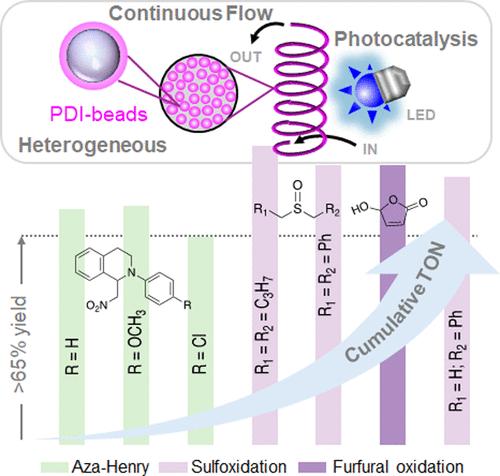PDI-Functionalized Glass Beads: Efficient, Metal-Free Heterogeneous Photocatalysts Suitable for Flow Photochemistry
IF 3.1
3区 化学
Q2 CHEMISTRY, APPLIED
引用次数: 0
Abstract
Perylene diimides (PDI) have an extraordinary ability to activate both energy and electron transfer processes upon light excitation; however, their extremely low solubility has hindered their wide use as photocatalysts. Here, we show that the combination of solid-supported PDIs with continuous flow photochemistry offers a promising strategy for process intensification and a scalable platform for heterogeneous photocatalysis. The photocatalyst immobilized onto glass beads is highly efficient, easy to separate, and extremely reusable, with a broad synthetic application range. Using the photo-oxidation of n-butyl sulfide as a benchmark reaction, we demonstrate that immobilized PDI are highly active, outperforming reported homogeneous photosensitizers, and capable of extensive reuse (turnover number (TON) >57,000 over 2 months). Transferring the process from batch to flow results in a 10-fold reduction in irradiation time and an increase in the space-time yield by a factor of 33 (40 vs 1338 mmol–1 h–1 L–1 batch vs flow). What is more, the same catalyst sample can be used for the preparation of a range of sulfoxides, the aza-Henry reaction between nitromethane and N–Ar tetrahydroisoquinolines, and the photo-oxidation of furfural with high catalytic activity. Overall, our work combines the remarkable photocatalytic properties of PDI with inert, easy-to-handle glass beads, producing hybrid materials that are reusable and can be adapted for performing heterogeneous photocatalysis in a range of scalable photochemical reactors.

PDI 功能化玻璃珠:适用于流动光化学的高效、无金属异质光催化剂
过二亚胺(PDI)在光激发下具有激活能量和电子转移过程的非凡能力;然而,其极低的溶解度阻碍了其作为光催化剂的广泛应用。在这里,我们展示了固体支撑的 PDI 与连续流光化学的结合,为工艺强化提供了一种前景广阔的策略,也为异质光催化提供了一个可扩展的平台。固定在玻璃珠上的光催化剂效率高、易分离、可重复使用,具有广泛的合成应用范围。以正丁基硫醚的光氧化反应为基准,我们证明了固定化 PDI 具有很高的活性,优于已报道的均相光敏剂,并且能够广泛重复使用(2 个月内的周转次数为 57,000 次)。将批量工艺转换为流动工艺后,辐照时间缩短了 10 倍,时空产量增加了 33 倍(批量与流动相比,时空产量分别为 40 与 1338 mmol-1 h-1 L-1)。此外,同一催化剂样品还可用于制备一系列硫氧化物、硝基甲烷与 N-Ar 四氢异喹啉的偶氮-亨利反应以及糠醛的光氧化反应,并具有很高的催化活性。总之,我们的工作将 PDI 的显著光催化特性与惰性、易于处理的玻璃珠相结合,生产出了可重复使用的混合材料,并可用于在一系列可扩展的光化学反应器中进行异相光催化。
本文章由计算机程序翻译,如有差异,请以英文原文为准。
求助全文
约1分钟内获得全文
求助全文
来源期刊
CiteScore
6.90
自引率
14.70%
发文量
251
审稿时长
2 months
期刊介绍:
The journal Organic Process Research & Development serves as a communication tool between industrial chemists and chemists working in universities and research institutes. As such, it reports original work from the broad field of industrial process chemistry but also presents academic results that are relevant, or potentially relevant, to industrial applications. Process chemistry is the science that enables the safe, environmentally benign and ultimately economical manufacturing of organic compounds that are required in larger amounts to help address the needs of society. Consequently, the Journal encompasses every aspect of organic chemistry, including all aspects of catalysis, synthetic methodology development and synthetic strategy exploration, but also includes aspects from analytical and solid-state chemistry and chemical engineering, such as work-up tools,process safety, or flow-chemistry. The goal of development and optimization of chemical reactions and processes is their transfer to a larger scale; original work describing such studies and the actual implementation on scale is highly relevant to the journal. However, studies on new developments from either industry, research institutes or academia that have not yet been demonstrated on scale, but where an industrial utility can be expected and where the study has addressed important prerequisites for a scale-up and has given confidence into the reliability and practicality of the chemistry, also serve the mission of OPR&D as a communication tool between the different contributors to the field.

 求助内容:
求助内容: 应助结果提醒方式:
应助结果提醒方式:


